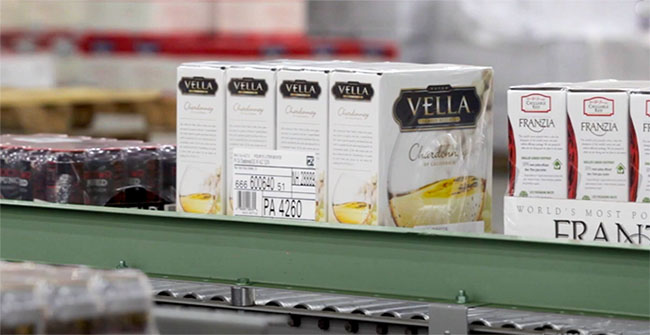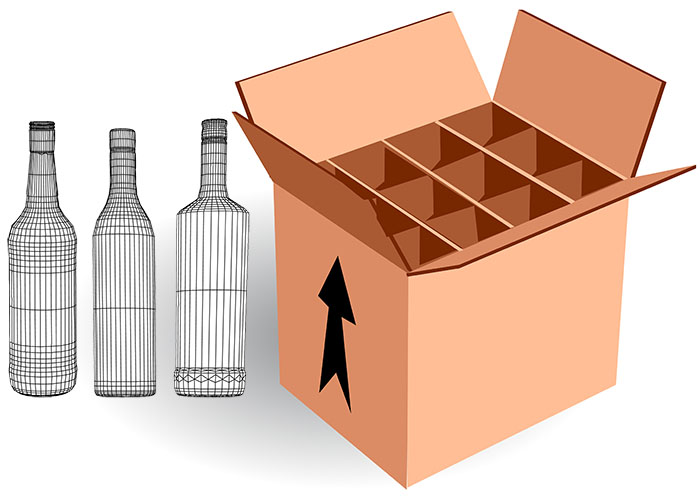How to Convey Heavy, Fragile Cartons
Beverages and liquor present unique product transport, accumulation and sortation challenges

Beverage handling systems have always been challenging. Cartons of expensive wine and liquor are heavy – and dense. And prone to damage. Sometimes these loads can be perishable and need to move fast through a system from picking to packing. The need to serve both retail and ecommerce customers from the same facility also complicates these design challenges.
Handling and transporting liquor: the challenges
Your picking system must take a wide variety of load types into account at all points along the way. You may need to accommodate mixed each-picks for ecommerce on the same conveyor lines that service case picks of heavy wine bottles. What type of storage media serves these needs best? What types of conveyors will serve all masters? You may need to pick and ship commerce orders on the same conveyors as full or broken cases f.
Both the cartons and (to a lesser extent) the bottles they hold must be accounted for in your material handling system design.
Perishable, breakable loads: cases of glass bottles

These loads combine weight with fragility.
Product damage and reduced efficiency are inevitable unless the system is designed to prevent them. An order picker who pulls cases from flow or static storage should be able to do so from an ergonomic position, which help reduce breakage and improve ergonomics. You must transport and sort cases gently. Design interactions along the way for gentle handling.
Fragile, heavy loads demand gentle handling
Above: Access cartons from the ergonomic gold zone at approximately waist height. Picking this carton doesn’t require excessive bending or stretching or straining.
- Fragility is the chief issue. Expensive liquor has a high cost-per-ounce, meaning that gentle conveyance and handling is critical.
- Weight: wine cases weigh from 30 to 40 pounds each. Whisky and other liquor tends to weigh less but is still heavy.
- Size variability: handling cases of various sizes on the same line means that the conveyor must be specified to accommodate the largest case, while still handling much smaller cartons, like single servings or small batch cases.
- Orientation: For most downstream processes, such as scanning, stamp applications, or diverting, product orientation is critical. Maintaining the proper orientation of liquor cases on the conveyor is crucial to prevent damage to the bottles inside and ensure smooth handling throughout the distribution process.
- Temperature controls: Some liquors, particularly wines, must be stored and handled in such a way that maintains recommended temperatures.
- Ergonomics: Pickers shouldn’t be lifting 40-pound cases off the bottom shelf, nor shouldering them down from the top. They should be stored in ergonomic golden zones, with little effort required to remove them from storage and onto a conveyor. This limits the number of ideal storage positions.
- Product viability: while preventing breakage is critical, some types of liquor should be prevented from jostling or vibrating.
Conveyor types

Belt conveyors are good because they provide the most stability and product traction. Belt conveyors are usually the gentlest way to handle a load, particularly if you need to decline or incline the conveyor.
Rollers are used for applications with the most reliable carton bottoms, where the product may need to be rotated or singulated for a down-line process. In some areas, gravity roller spurs are used to take cases from a line for packing or other work. Roller system let you easily accumulate cartons, change zones, or change spacing on the system.
Plastic chain systems are used when washdown capabilities are needed or specific food handling guidelines must be met.
Vertical conveying: When you change levels, incline conveyors will gently handle cartons without box tumbling. Spiral systems can do the same while they occupy less space. Package handling VRCs are also used in some instances.
Sortation systems: Shoe sorting to perpendicular lines is one of the gentlest ways to sort these types of loads. You can utilize pop-up rollers or belt sorters as well, depending on desired speed and application. The way you sort heavier cartons relies extensively on other operational factors. In general, favor methods that are gentler over speed. You can increase throughput before and after the point of sortation as needed.
Truck loading: Extendable belt conveyors let you transport cartons to their endpoint in a truck trailer This reduces manual touches where breakage is more possible and lets warehouse workers operate faster and more ergonomically.
It’s a balance between speed, efficiency and product protection
More than most any industry, beverage distribution operations require forethought and systems design that helps protect the load while moving it quickly through the process. Finding that balance will let you reduce breakage and deliver faster.
Read more
- Automated Vision System Helps Liquor Distribution Operation
- How to Pick Cases Faster and More Efficiently
- Warehouse Ergonomics for Order Picking
Tags: order fulfilment, warehousing, product damage, ergonomics
Scott Stone is Cisco-Eagle's Vice President of Marketing with 35 years of experience in material handling, warehousing and industrial operations. His work is published in multiple industry journals an websites on a variety of warehousing topics. He writes about automation, warehousing, safety, manufacturing and other areas of concern for industrial operations and those who operate them.




